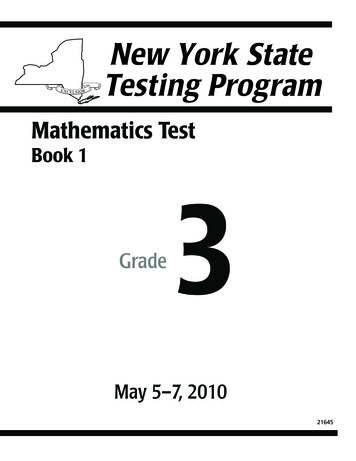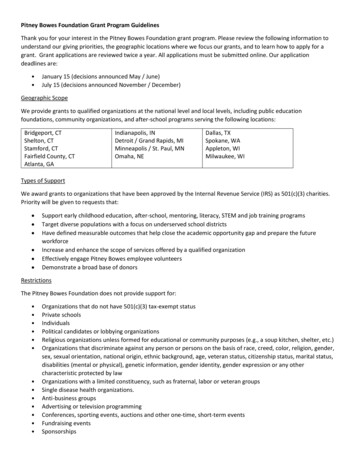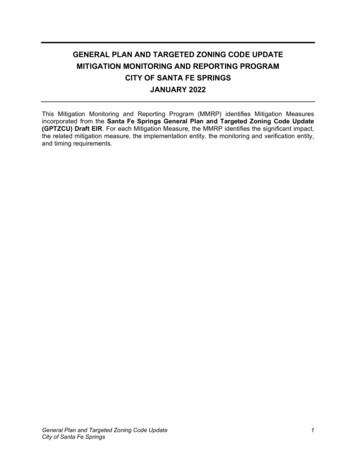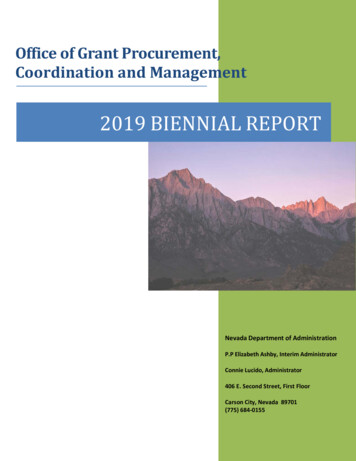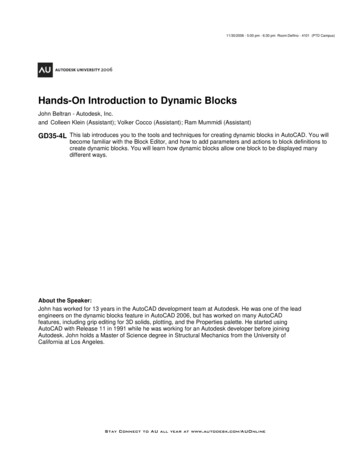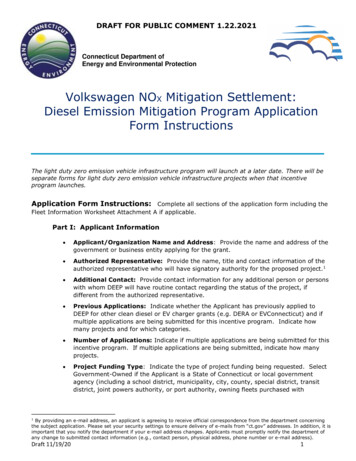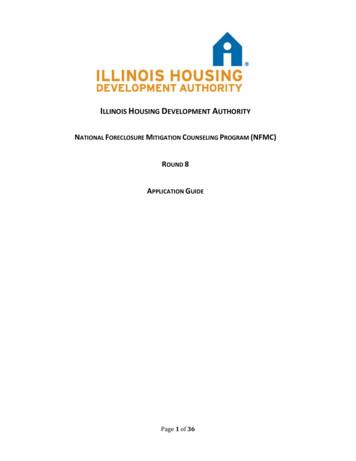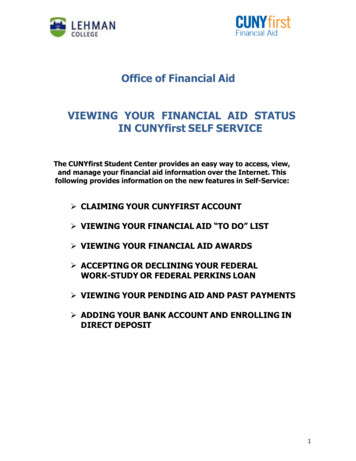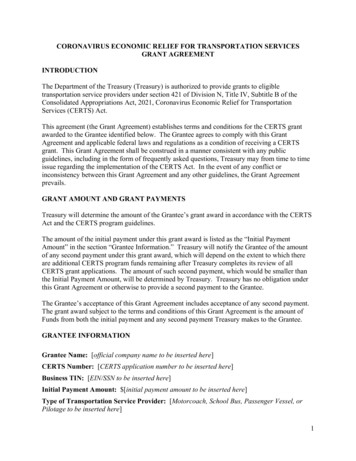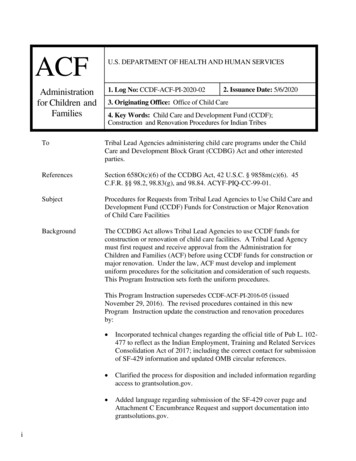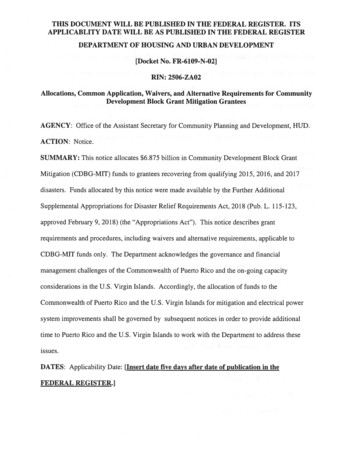
Transcription
THIS DOCUMENT WILL BE PUBLISHED IN THE FEDERAL REGISTER. ITSAPPLICABLITY DATE WILL BE AS PUBLISHED IN THE FEDERAL REGISTERDEPARTMENT OF HOUSING AND URBAN DEVELOPMENT[Docket No. FR-6109-N-02JRIN: 2506-ZAO2Allocations, Common Application, Waivers, and Alternative Requirements for CommunityDevelopment Block Grant Mitigation GranteesAGENCY: Office of the Assistant Secretary for Community Planning and Development, HUD.ACTION: Notice.SUMMARY: This notice allocates 6. 75 billion in Community Development Block GrantMitigation (CDBG-MIT) funds to grantees recovering from qualifying 2015, 2016, and 2017disasters. Funds allocated by this notice were made available by the Further AdditionalSupplemental Appropriations for Disaster Relief Requirements Act, 201 (Pub. L. 115-123,approved February 9, 2018) (the “Appropriations Act”). This notice describes grantrequirements and procedures, including waivers and alternative requirements, applicable toCDBG-MIT funds only. The Department acknowledges the governance and financialmanagement challenges of the Commonwealth of Puerto Rico and the on-going capacityconsiderations in the U.S. Virgin Islands. Accordingly, the allocation of funds to theCommonwealth of Puerto Rico and the U.S. Virgin Islands for mitigation and electrical powersystem improvements shall be governed by subsequent notices in order to provide additionaltime to Puerto Rico and the U.S. Virgin Islands to work with the Department to address theseissues.DATES: Applicability Date: [Insert date five days after date of publication in theFEDERAL REGISTER.]
2FOR FURTHER INFORMATION CONTACT: Jessie Handforth Kome, Acting Director,Office of Block Grant Assistance, Community Planning and Development, Department ofHousing and Urban Development, 451 7th Street, SW, Room 7282, Washington, DC 20410,telephone number 202-402-3587. Persons with hearing or speech impairments may access thisntimber via TTY by calling the Federal Relay Service at 800-877-8339. Facsimile inquiries maybe sent to Ms. Kome at 202-708-0033. (Except for the’800’ number, these telephone numbersare not toll-free). Email inquiries may be sent to disaster recovery@hud.gov.SUPPLEMENTARY INFORMATION:Table of ContentsI.Overview and Policy ObjectivesII.Use of CDBG-MIT FundsA. Mitigation DefinitionB. Action Plan, Substantial Amendments, and Covered ProjectsC. Most Impacted and Distressed AreasHI.AllocationsIV.Overview of Grant ProcessV.Applicable Rules, Statutes, Waivers, and Alternative RequirementsA. Grant Administration and Action Plan RequirementsB. Housing and Related Floodplain IssuesC. InfrastructureD. Economic DevelopmentVI. Certifications and Collection of InformationVII. Duration of Funding
3VIII. Catalog of Federal Domestic AssistanceIX.Finding of No Significant ImpactI. Overview and Policy ObjectivesThe Further Additional Supplemental Appropriations for Disaster Relief RequirementsAct, 201 (Division B, Subdivision 1 of the Bipartisan Budget Act of 2018, Pub. L. 115-123,approved February 9, 201 ) (the “Appropriations Act”), made available 28 billion inCommunity Development Block Grant disaster recovery (CDBG-DR) funds, and directed HUDto allocate not less than 12 billion for mitigation activities proportional to the amounts thatCDBG-DR grantees received for qualifying disasters in 2015, 2016, and 2017. This noticeaccordingly allocates 6,875,044,000 in CDBG-MIT funds for mitigation activities consistentwith the Appropriations Act.CDBG-MIT funds represent a unique and significant opportunity for grantees to use thisassistance in areas impacted by recent disasters to carry out strategic and high-impact activitiesto mitigate disaster risks and reduce future losses. While it is impossible to eliminate all risks,CDBG-MIT funds will enable grantees to mitigate against disaster risks, while at the same timeallowing grantees the opportunity to transform State and local planning.Through this allocation for mitigation, HUD seeks to: Support data-informed investments in high-impact projects that will reduce risksattributable to natural disasters, with particular focus on repetitive loss of property andcritical infrastructure; Build the capacity of States and local governments to comprehensively analyze disasterrisks and to update hazard mitigation plans through the use of data and meaningfulcommunity engagement;
4Support the adoption of policies that reflect local and regional priorities that will havelong-lasting effects on community risk reduction, to include the risk reduction tocommunity lifelines such as Safety and Security, Communications, Food, Water,Sheltering, Transportation, Health and Medical, Hazardous Material (management) andEnergy (Power & fuel); and future disaster costs (e.g. adoption of forward-looking landuse plans that integrate the hazard mitigation plan, latest edition of the published disaster-resistant building codes and standards (to include wildiand urban interface, flood and allhazards, ASCE-24, and ASCE-7 respectively), vertical flood elevation protection, andpolicies that encourage hazard insurance for private and public facilities); and Maximize the impact of availabte funds by encouraging leverage, private-publicpartnerships, and coordination with other Federal programs.The guiding structure and objectives established for CDBG-MIT funds bear similaritiesto other federal programs that address hazard mitigation, particularly FEMA’s Hazard MitigationGrant Program (HMGP). Accordingly, HUD has structured this notice and its requirements tocomplement HMGP policies and processes where possible. For example, both CDBG-MITfunds and FEMA HMGP funds require grantees to conduct a multi-hazard risk assessment toinform projects and programs. Additionally, grantee use of CDBG-MIT funds will be focusedon effectively addressing risks to indispensable services that enable the continuous operation ofcritical business and government functions, and that are critical to the protection of human healthand safety, or economic security, as described in section V.A.2.a.(1) of this notice.The Appropriations Act provides CDBG-MIT funds as a supplemental appropriation tothe Community Development Block Grant (CDBG) program. Accordingly, the alignment ofCDBG-MIT funds with other federal mitigation programs must also occur within the basic
5CDBG framework. The national objectives of the CDBG program are: a) providing benefit tolow- and moderate-income persons; b) preventing or eliminating slum and blighting conditions;or c) addressing a severe and recently arising urgent community welfare or health need. Unlikeother forms of Federal disaster recovery assistance, CDBG-DR and CDBG-MIT grants have astatutory focus on benefiting vulnerable lower-income people and communities and targeting themost impacted and distressed areas.The Appropriations Act requires that prior to the obligation of CDBG—DR funds by theSecretary, a grantee shall submit a plan to HUD for approval detailing the proposed use of allfunds including the criteria for eligibility and how the use of these funds will address mitigationin the most impacted and distressed (MID) areas. The Appropriations Act also provides HUDwith waiver authority that enabled HUD to modify the basic CDBG requirements to supporthazard mitigation when needed. However, there are several statutory requirements under thebasic CDBG framework (e.g., requirements related to labor standards, nondiscrimination, theenvironment and fair housing) which HUD is not authorized to waive. Because this frameworkwill largely remain intact throughout this notice and to ensure compliance with all applicableprogram requirements, HUD strongly encourages grantees to designate the agency thatadministers its CDBG-DR funds to also administer this CDBG-MIT grant.The notice also balances the goals of aligning mitigation policies across federally-fundedprograms, maximizing efficiencies, and preserving critical aspects of the CDBG structure. Asdiscussed in section V.A. of this notice, Grant Administration and Action Plan Requirements,grantees are encouraged to use CDBG-MIT planning funds to update the FEMA-approvedHazard Mitigation Plans (HMP) and are required to reference the applicable FEMA HMP in theiraction plan and describe how the HMP has informed the CDBG-MIT action plan. Grantees may
6also use these funds for planning activities, including but not limited to regional mitigationplanning, the integration of mitigation plans with other planning initiatives, activities related toFEMA’s Pre-Disaster Mitigation (PDM, to be renamed Building Resilient and InfrastructureCommunities (BRIC) as part of implementation of section 1234 of the Disaster RecoveryReform Act of 201 , which amended section 203 of the Stafford Act (42 U.S.C. 5133)) andFlood Mitigation Assistance (FMA), modernizing building codes and regional land-use plans,and upgrading mapping, data, and other capabilities to better understand evolving disaster risks.For example, in wildland fire risk areas, grantees may use these funds to develop a CommunityWildfire Protection Plan (CWPP). Additionally, State grantees are encouraged to use CDBGMIT planning funds to meet the additional requirements for an enhanced HMP and for eligibleCDBG-Mff activities that increase a grantee’s capacity to participate in FEMA’s HMGPProgram Administration by States (PAS) initiative. This use of CDBG-MIT funds, incombination with FEMA HMGP assistance, will have long-term benefits by supporting highquality mitigation planning, building a foundation for continuous coordination and data-drivenoutcomes, and providing common goals for selecting high impact projects across multipleprograms and funding sources.HUD recognizes that this first-time appropriation of mitigation-only CDBG funds maypose challenges to grantees in aligning their mitigation strategies and activities with theirobligation to use most of their CDBG-MIT funds to benefit low- and moderate-income personsand to use the funds in the MID areas resulting from a disaster. Accordingly, this noticeprovides grantees with flexibility on the percentages related to a CDBG-MIT grant’s overallbenefit requirement and MID expenditure requirement. As with CDBG-DR, HUD encouragesCDBG-MIT grantees to consider a wide range of community development objectives related to
7recovery and economic resilience. This notice provides a waiver and establishes an alternativerequirement to include new urgent need national objective criteria that are applicable to CDBGMIT funds only, as described in section V.A.13. of this notice. This urgent need mitigation(UNM) national objective requires activities funded with the CDBG-MIT grant to result inmeasurable and verifiable reductions in the risk of loss of life and property from future disastersand yield community development benefits. The waiver and alternative requirement in sectionV.A.13. also explains that grantees shall not rely on the national objective criteria for eliminationof slum and blighting conditions without approval from HUD, because this national objectivegenerally is not appropriate in the context of mitigation activities.CDBG-MIT funds are to be used for distinctly different purposes than CDBG-DR funds.The amount of funding provided through this CDBG-MIT allocation and the nature of theprograms and projects that are likely to be funded requires that CDBG-MIT grantees and theirsubrecipients strengthen their program management capacity, financial management, and internalcontrols. Each grantee is required to strengthen its internal audit function, specify the criteria forsubrecipient selection, increase subrecipient monitoring, and establish a process for promptlyidentifying and addressing conflicts under the grantee’s conflict of interest policy. TheDepartment also intends to establish special grant conditions for individual CDBG-MIT grantsbased upon the risks posed by the grantee, including risks related to the grantee’s capacity tocarry out the specific programs and projects proposed in its action plan. These conditions will bedesigned to provide additional assurances that mitigation programs are implemented in a mannerto prevent waste, fraud, and abuse and that mitigation projects are effectively operated andmaintained.
8While CDBG-DR and CDBG-MIT funding are valuable resources for long-term recoveryand mitigation in the wake of major disasters, HUD concurrently expects that grantees will takesteps to set in place substantial governmental policies and infrastructure to enhance the impact ofHUD-funded investments. In some instances, this goal may be achieved through thedevelopment and application of more stringent building and zoning codes which will help tolimit damage from future severe weather events. It should be noted that these actions are eligiblecosts under CDBG-DR or CDBG-MIT funding.Consistent with prior CDBG-DR notices, HUD restates that disaster recovery is apartnership between Federal, state, and local government and CDBG-MIT grantees should investin their own recovery. To sustain CDBG-MIT physical investments in the future, it is imperativethat grantees collect and apply sufficient revenues for operation and maintenance costs in theoutyears. HUD expects grantees to contribute to their recovery through the use of reserve or“rainy day” funds, borrowing authority, or retargeting of existing resources. The ultimate valueof this mitigation funding appropriation is not limited to the projects and activities implementedwith the funds but will also encompass how state and local partners are motivated to improvemany of their governmental functions to better position jurisdictions to be resilient in the face offuture disasters. HUD will examine how grantees plan to achieve this broader benefit and willpromote best practices to future CDBG-DR grantees.It is the policy of the Administration that this first implementation of CDBG-MITfunding be implemented in a manner that mandates careful planning, adequate oversight, andincreased reporting of anticipated and actual outcomes of the uses of the mitigation funds, toinform future Federal disaster mitigation efforts, to encourage private sector funding ofmitigation projects, and to maximize the benefits of CDBG-Mff funding.
9The Administration cannot emphasize strongly enough the need for grantees to fully andcarefully evaluate the projects that will be assisted with CDBG-MIT funds. One of the goals ofCDBG-MIT is to set a nationwide standard that will help guide not just future Federalinvestments in mitigation and resilience activities—to include the mitigation of communitylifelines, but state and local investments as well. The level of CDBG-MIT funding available tomost grantees cannot address the entire spectrum of known mitigation and resilience needs.Accordingly, HUD expects that grantees will rigorously evaluate proposed projects and activitiesand view them through several lenses before arriving at funding decisions, including ensuringthat already committed public or private resources are not supplanted by CDBG-MIT funds.One such lens could be a thorough consideration of projects and activities encompassedwithin the applicable FEMA HMP and a judgment of whether those projects/activities representtargeted strategic investments for the grantee based on current or foreseeable risks. Thisjudgment would stand in contrast to the funding of projects/activities identified in such planswhere, for example, there has been no recent review of the risk reduction value of the investmentor the project/activity has been carried in the plan for years but has limited risk reduction value.A second lens could be a consideration of the status of necessary planning and permittingefforts. To ensure that CDBG-MIT investments have the highest possible impact on long-termmitigation and resilience needs, each grantee should conduct a careful status review of planningand permitting actions for proposed projects/activities and identify those that can move forwardquickly. Concurrently, this exercise can help to identify Federal regulatory relief that is criticalto helping clear the path for these projects/activities. In this vein, the Administration expects thatgrantees will conduct a review of and make necessary changes and exceptions to their ownpermitting and related processes to expedite funded projects/activities. In undertaking this
10analysis, grantees should not succumb to the urge to select projects/activities solely because theyare the most advanced in the planning and permitting process but should focus on high impactinvestments and a thorough understanding of what will be necessary to move those investmentsforward rapidly.The notice includes several waivers and alternative requirements typically established inCDBG-DR Federal Register notices but modified as necessary to reflect the distinct purpose ofCDBG-MIT funds. The Department cannot anticipate every type of mitigation project orprogram that will be proposed by grantees, but these activity-based waivers and alternativerequirements are intended to provide grantees with continued flexibility in the design andimplementation of comprehensive mitigation programs and projects.For purposes of this notice, HUD is using the terms CDBG-MIT programs and projects torefer to the means by which grantees implement CDBG eligible activities. This notice alsoreferences the general categories of infrastructure and public facilities, housing, planning andadministration, public services, and economic development that grantees often use to groupactivities in an action plan, in the DRGR action plan, and in quarterly performance reports.II. Use of CDBG-MIT FundsII.A. Mitigation Definition.For the purposes of this notice, mitigation activities are defined as those activities thatincrease resilience to disasters and reduce or eliminate the long-term risk of toss of life, injury,damage to and loss of property, and suffering and hardship, by lessening the impact of futuredisasters.II.B. Actioit Plan, Substantial Amendments, and Amendments for covered Projects.
11Before the Secretary obligates CDBG-MIT funds to a grantee, the Appropriations Actrequires the grantee to submit a plan to HUD for approval detailing the proposed use of all funds.All or a portion of an action plan or substantial amendment will be substantially incomplete if theplan does not include the elements required by this notice. A grantee’s use of CDBG-MIT fundsmust be consistent with its action plan.All CDBG-MIT activities must: (1) meet the definition of mitigation activities above; (2)address the current and future risks as identified in the grantee’s Mitigation Needs Assessment ofmost impacted and distressed areas (described below); (3) be CDBG-eligible activities under titleI of the Housing and Community Development Act of 1974 (HCDA) or otherwise eligiblepursuant to a waiver or alternative requirement; and (4) meet a national objective, includingadditional criteria for mitigation activities and Covered Projects. The action plan must describehow funded activities satisfy these requirements.As mentioned above, the action plan must include a risk-based Mitigation NeedsAssessment that identifies and analyzes all significant current and future disaster risks andprovides a substantive basis for the activities proposed. To complete this assessment, granteesmust consult with other jurisdictions, the private sector and other government agencies, includingState and local emergency management agencies that have primary responsibility for theadministration of FEMA mitigation funds, including the State Hazard Mitigation Officer(SHMO), for HMGP alignment. Grantees must also use the most recent risk assessmentcompleted or currently being updated through the FEMA HMP process to inform the use CDBGMIT funds. Therefore, the grantee must use the risks identified in the FEMA approved HMP asthe starting point for its Mitigation Needs Assessment unless the jurisdiction is in the process ofupdating the HMP. If a jurisdiction is currently updating an expired HMP, the grantee
12administering the CDBG-MIT funds must consult with the agency administering the HMPupdate to identify the risks that will be included in the Mitigation Needs Assessment. The actionplan must describe proposed allocations of CDBG-MIT funds that meet all of the requirementslisted above in this section.To maximize the impact of all available funds, grantees must coordinate and align theseCDBG-MIT funds with other mitigation projects funded by FEMA, the U.S. Army Corps ofEngineers (USACE), the U.S. Forest Service, and other agencies as appropriate. For example, inwildiand fire prone areas, this would include federal and state forestry and fire agencies thatcarry out activities related to fire risk reduction.Grantees must describe in their action plan how they have coordinated and will continueto coordinate with other partners who manage FEMA and USACE funds and describe the actionsthat they have taken to align their planned CDBG-MIT activities with other federal, state, andlocal mitigation projects and planning processes.To allow for a more detailed review of larger projects, this notice requires thatinfrastructure projects that also meet the definition of a Covered Project be included in an actionplan or a substantial action plan amendment. For purposes of this notice, a Covered Project isdefined as an infrastructure project having a total project cost of 100 million or more, with atleast 50 million of CDBG funds (regardless of source (CDBG-DR, CDBG-National DisasterResilience (NDR), CDBG-MIT, or CDBG)). For grantees that are considered by HUD to have“unmitigated high risks,” that impact their ability to implement large scale projects, HUD mayimpose special grant conditions, including but not limited to a lower dollar threshold for thedefinition of a Covered Project.
13As described in section V.A.2.h. below, when a grantee proposes a Covered Project, theaction plan or substantial amendment must include a description of the project and theinformation required for other CDBG-MIT activities (how it meets the definition of a mitigationactivity, consistency with the Mitigation Needs Assessment provided in the grantee’s action plan,eligibility under section 105(a) of the HCDA or a waiver or alternative requirement, and nationalobjective, including additional criteria for mitigation activities). Additionally, the action planmust describe how the Covered Project meets additional criteria for national objectives forCovered Projects (described in V.A.13. below) including: consistency with other mitigationactivities in the same MID area; demonstrated long-term efficacy and sustainability of the projectincluding its operations and maintenance; and a demonstration that the benefits of the CoveredProject outweigh the costs (through the methods described in V.A.2.h.).II.C. Most Impacted and Distressed Areas.The Appropriations Act made CDBG-MIT funds available for eligible activities relatedto the mitigation of risks within the MD areas. This notice lists the HUD-identified MD areasfor each CDBG-DR grantee receiving an allocation of CDBG-MIT funds. The HUD-identifiedMD areas for each CDBG-MIT grant are those identified by HUD in the following FederalRegister notices for the grantee’s 2015, 2016, or 2017 CDBG-DR grants (collectively, the “PriorNotices”): 2015 Disasters: 81 FR 39687; 82 FR 36812; 2016 Disasters: 1 FR 3254; 82 FR 5591; 82 FR 36 12; and 2017 Disasters: 2 FR 61320; 83 FR 5844; 83 FR 40314.The amount of CDBG-MIT funding grantees must expend to mitigate risks within theHUD-identified MID areas is listed in Table 1. In some instances, HUD previously identified
14the entire jurisdiction of a grantee as the MID area. For all other CDBG-MIT grantees, HUD isrequiring that at least 50 percent of all CDBG-MIT funds must be used for mitigation activitiesthat address identified risks within the HUD-identified MD areas. HUD will include 50 percentof a grantee’s expenditures for grant administration in its determination that 50 percent of thetotal award has been expended in the HUD identified MID areas. Additionally, expenditures forplanning activities may be counted towards a grantee’s 50 percent MID expenditure requirement,provided that the grantee describes in its action plan how those planning activities benefit theHUD identified MID areas.HUD may approve a grantee’s request to add other areas to the HUD-identified MIDareas based upon the grantee’s submission of a data-driven analysis that illustrates the basis fordesignating the additional area as most impacted and distressed as a result of the qualifyingdisaster. As the HUD-identified MD areas for CDBG-MIT funds are the same as thoseidentified for each grantee in the Prior Notices, a grantee seeking to amend its HUD-identifiedMID area for purposes of its CDBG-MIT grant, must also amend the HUD-identified MID areafor its corresponding 2015, 2016, or 2017 CDBG-DR grant. Grantees proposing to add to theHUD-identified MID area for their existing CDBG-DR grant shall do so through a substantialamendment that includes a consideration of unmet housing recovery needs. The grantee mustalso undertake a substantial amendment to its CDBG-MIT action plan so that the HUD-identifiedMID areas are the same across both grants. The grantee may submit the substantial amendmentsfor both grants simultaneously.Grantees may determine where to use the remaining 50 percent of the CDBG-MIT grant(the grantee-identified MID areas), but that portion of the grant must be used for mitigationactivities that address identified risks within those areas that the grantee determines are most
15impacted and distressed resulting from the major disasters identified by the disaster numberslisted in Table 1. The grantee-identified MID areas must be determined through the use ofquantifiable and verifiable data.Grantee expenditures for eligible mitigation activities outside of the HUD-identified orgrantee-identified MD area may be counted toward the MID area expenditure requirementsprovided that the grantee can demonstrate how the expenditure of CDBG-MIT funds outside ofthis area will measurably mitigate risks identified within the HUD-identified or granteeidentified MID area (e.g., upstream water retention projects to reduce downstream flooding inthe HUD-identified MID area).
16IlL Allocations: TABLE 1- ALLOCATIONS FOR MITIGATION ationInMininim amount thatnwstbeexpendedintheHIJD-identified “mostHUB-identified mostimpacted and distressed’.impacted andareasdistressed areas listedhereinSonoma and Ventura counties: 44,109,500.0093108. 91558. 95422, 95470.and 95901 Zip Codes.Brevard, Broward, Clay.5316,742,500.00Collier, Duvak Hilisborough.Lee, Miani Dade, Monroe,Orange. Osceola. Palm Beach,Polk. St. Johns, St. Lucie, andVolusia counties; 32084,32091, 32136, 32145, 32771,33440. 33523, 33825, 33870,32068, 33935, and 34266 ZipCodes.31520, 31548, and 31705 Zip 13,480,500.00Codes.East Baton Rouge, Livingston, 606,958,500.00Ascension. Tangipahoa,Ouachita, Letavette, Vemilion.Acadia, Washington. and St.Taniniany Parishes.4344: 4353CahlbmiaState of Calitbmia588,2 19,000.004280:4283;4337: 4341FloridaState of Florida 633,485,000.004294; 4297;43384263; 4277;4272GeorgiaState of Georgia 26.96 1,000.00LouisianaState of Louisiana 1,213,917,000.004317MissouriState of Missouri 41,592,000.00 20,796,000.004285North CarolinaState of North Carolina5168,067.000.00 84,033,500.004241:4286South CarolinaState of South Carolina 157,590,000.00 50,978,000.0042414241ColumbiaLexington County (Urban County) 18,585,000.00 15.1 85,000.00 18,585,000.00 15,185,000.004241Richland County ( Urban County) 21,864,000.00 21,864,000.00State of Texas 4,297,189,000.0052,105,646,500.00Houston 61,884,000.00 61,884,000.00Houston.San MarcosState of West Virginia524.012,000.005106,494.000.00 24.01 2,000.00553,247,000.00San Marcos.Greenbrier, Clay, Kanawha andNicholas Counties.4223: 4245;4266: 4269:4272: 4332Texas4223: 42454223: 42454273West VirginiaTotalt: 56.875,044.000.00tTbe remaining 59.059.472,000 will be allocated at a later date.63935, 63965. 64850, 65616.and 65775 Zip Codes.Bladen, Columbus, Cumberland,Edgecombe. Robeson. andWayne Counties.Charleston, Clarendon,Dorchester, Florence,Georgetown, Hony, Marion,Sumter, and WilliamsburgCounties.Columbia.Lexington County Urban CountyJurisdictions.Richiand County Urban CountyJurisdictions.Aransas, Brazoria. Chambers,Fayette. Fort Bend, Galveston,Hardin. Harris. Hays, Hidalgo.Jasper, Jefferson, Liberty,Montgonety, Newton, Nueces,Orange. Refiigio, San Jacinto,San Patricio, Travis, Victoria,and Wharton counties; 75979,77320, 77335, 77351, 77414,77423, 77482, 77493. 77979,78934, 78945, 77612, 75956,77632, and 78377 Zip Codes.
17accordance with the Appropriations Act, HUDs allocation of CDBG-MIT funds is based oneach grantee’s proportional share of total CDBG-DR funds allocated for all eligible disasters in2015, 2016, and 2017.IV. Overview of Grant ProcessThe grant process outlined below aligns with the typical order employed for CDBG-DRgrants. However, the Department recognizes the potentially broad range of mitigation activitiesthat may be funded pursuant to this notice and the critical importance of coordinating thoseinvestments across multiple jurisdictions. Accordingly, the Department is providing extendedtime frames and mechanisms for on-going citizen participation in the development andimplementation of plans for mitigation activities funded pursuant to this notice.To begin expending CDBG-MIT funds, the following steps are necessary: Grantee develops or amends its citizen participation plan for disaster recovery per therequirements in section V.A.3 to provide for the mitigation funding. Grantee consults with stakeholders, including required consultation with affectedlocal governments, Indian Tribes, and public housing authoriti
Allocations, Common Application, Waivers, and Alternative Requirements for Community Development Block Grant Mitigation Grantees AGENCY: Office of the Assistant Secretary for Community Planning and Development, HUD. ACTION: Notice. SUMMARY: This notice allocates 6. 75 billion in Community Development Block Grant
